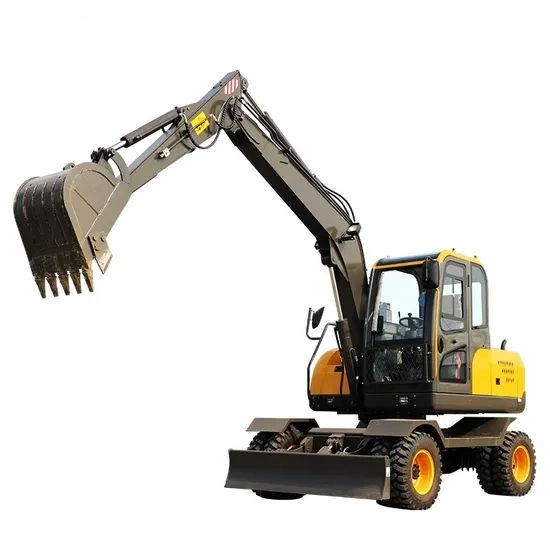Under the same tonnage, the "cost-effectiveness" of wheeled excavators and crawler excavators is not absolute; it depends on three core factors: operating scenarios, frequency of use, and cost structure. The differences in cost-effectiveness between the two are mainly reflected in aspects such as purchase cost, usage cost, operating efficiency, and residual value rate. The following is a comparative analysis from specific dimensions:

I. Comparison of Core Costs and Efficiency
| Dimension | Wheeled Excavators | Crawler Excavators |
|---|---|---|
| Purchase Cost | Higher (usually 10%-30% more expensive than crawler types of the same tonnage) —— The manufacturing cost of tires and wheeled traveling systems (gearboxes, drive axles, etc.) is higher. | Lower (more affordable price for the same tonnage) —— The crawler traveling system has a relatively simple structure and lower manufacturing cost. |
| Usage Cost | 1. Fuel consumption: Slightly lower (more energy-efficient than crawler types when driving, but fuel consumption is similar during operation) 2. Maintenance cost: Tires wear quickly (especially on gravel roads, with the cost of replacing one tire being about several thousand yuan); wheel reducers, gearboxes, etc., are prone to damage due to heavy loads; 3. Transfer cost: Extremely low (can move short distances on its own without a trailer). | 1. Fuel consumption: Slightly higher fuel consumption during operation (due to high crawler driving resistance) 2. Maintenance cost: Crawlers (chains, track plates) have a longer service life (can reach thousands of hours under normal use, with high replacement cost but long cycle); the hydraulic system is more durable (adapts to heavy loads); 3. Transfer cost: High (relies on trailer transportation, with a single cost ranging from several hundred to several thousand yuan). |
| Operating Efficiency | Suitable for light operations (such as earth loading/unloading, ground leveling), with efficiency close to that of crawler types; However, it is prone to slipping in soft ground or heavy-load scenarios, leading to a sharp drop in efficiency. | Suitable for high-intensity operations (such as crushing, deep foundation pit excavation); crawlers have strong grip and high operational stability, and their efficiency under heavy loads is far superior to that of wheeled types. |
| Residual Value Rate | Medium (5-year residual value rate is about 40%-50%) —— The aging of vulnerable parts such as tires affects the residual value, and the applicable scenarios are narrow, so the demand in the second-hand market is not as strong as that of crawler types. | Higher (5-year residual value rate is about 50%-60%) —— Crawler types have a wide range of applicable scenarios and good liquidity in the second-hand market, especially large-tonnage models are more value-preserving. |
II. Judgment of Cost-Effectiveness in Different Scenarios
1. Scenarios Where Wheeled Excavators Have Higher Cost-Effectiveness
- Urban municipal administration and frequent short-distance transfers:
If operations are concentrated on hardened roads (such as urban road maintenance, community renovation) and require short-distance movement between multiple construction sites (within 50 kilometers), the low transfer cost (no need for a trailer) and road protection advantages of wheeled excavators can significantly reduce the comprehensive cost. For example: In multiple small farmland renovation projects in rural areas, wheeled excavators can travel back and forth on their own, saving tens of thousands of yuan in trailer fees each year, offsetting the price difference at the time of purchase. - Mainly engaged in light operations:
If the work is mainly medium and low-intensity operations such as light earthwork, loading/unloading, and greening, the maintenance cost of wheeled excavators (tire wear) will not be too high, and fuel consumption is slightly lower, making them more cost-effective for long-term use. - Low frequency of use (annual operation < 1000 hours):
With low-frequency use, the impact of the high purchase cost of wheeled excavators is diluted, and the advantage of flexible transfer is more prominent (avoiding trailer fees during long-term idleness).
2. Scenarios Where Crawler Excavators Have Higher Cost-Effectiveness
- Complex terrain and high-intensity operations:
If operating in scenarios such as mines, muddy farmland, steep slopes, or requiring frequent crushing of hard rocks, the operating efficiency and stability of crawler types are irreplaceable by wheeled types. For example: In large infrastructure projects, the daily earthwork volume of crawler excavators can be more than 1.5 times that of wheeled types, with stronger ability to recover costs quickly. - Long-term fixed-site operations:
If operating at the same construction site for a long time (such as the construction of large factory areas) without frequent transfers, crawler types have advantages in low purchase cost and durability. Moreover, the crawler maintenance cycle is long (requiring overhaul on average after 5000 hours), resulting in lower long-term use costs. - High-frequency use (annual operation > 2000 hours):
Under high-frequency and high-intensity operations, the structural durability (hydraulic system, chassis) of crawler types is more reliable, with a lower failure rate than wheeled types (wheeled gearboxes and tires are prone to damage due to continuous heavy loads), reducing downtime losses and achieving higher comprehensive cost-effectiveness.
III. Summary: Core Judgment Formula for Cost-Effectiveness
Cost-effectiveness = Operating income ÷ Comprehensive cost
- When the operating scenarios are mainly hardened roads, short-distance transfers, and light operations, wheeled excavators have lower comprehensive costs and higher cost-effectiveness;
- When the operating scenarios involve complex terrain, high-intensity operations, and long-term fixed sites, crawler excavators have higher operating income (efficiency + stability) and better cost-effectiveness.
In short, there is no "absolutely more cost-effective" model, only a "more scenario-adapted" choice. Only models adapted to the scenario can achieve the highest cost-effectiveness by reducing costs and improving efficiency.





